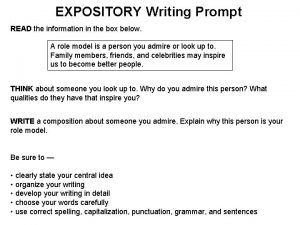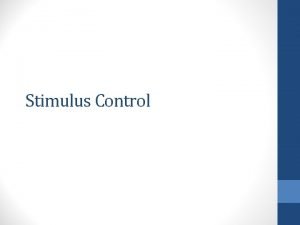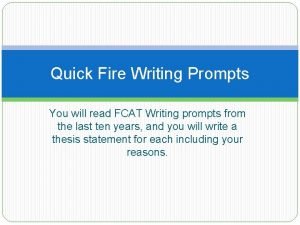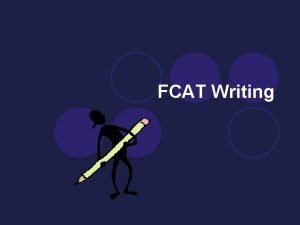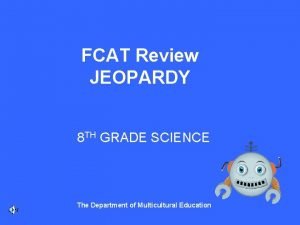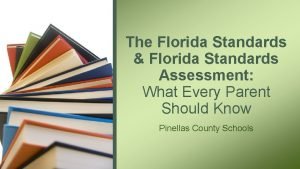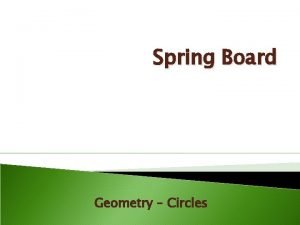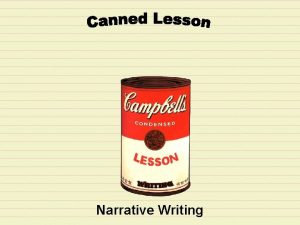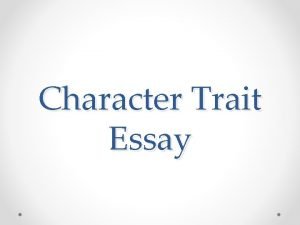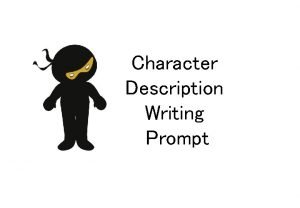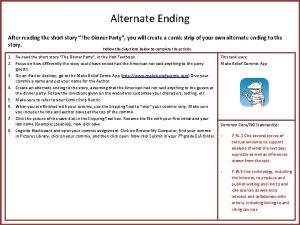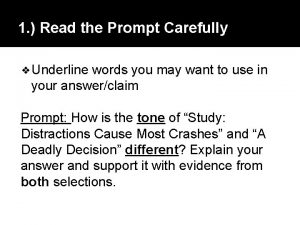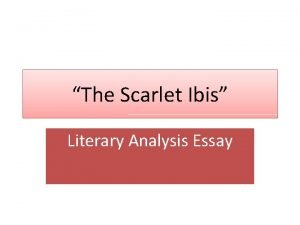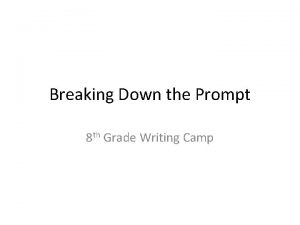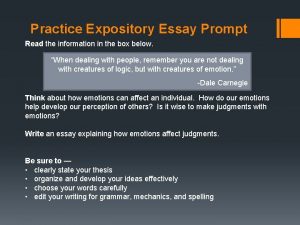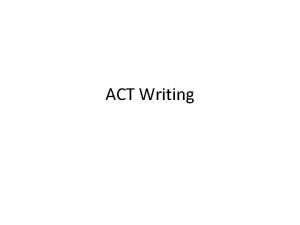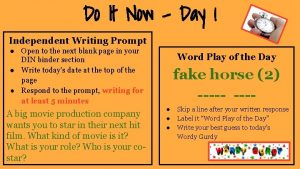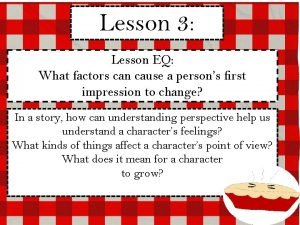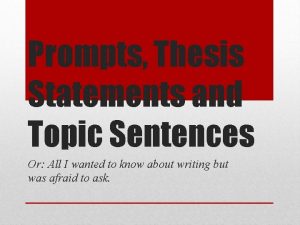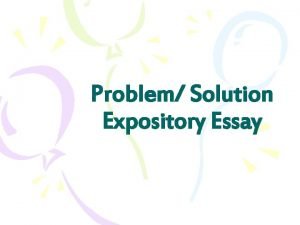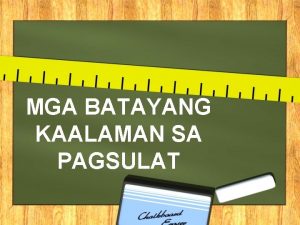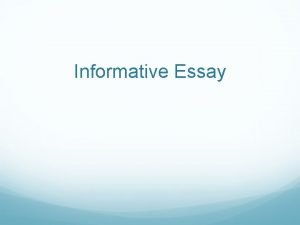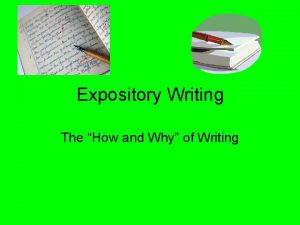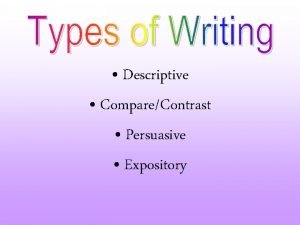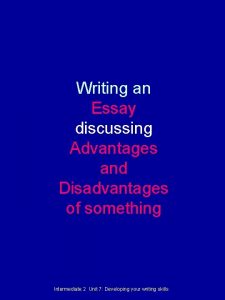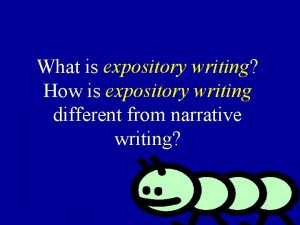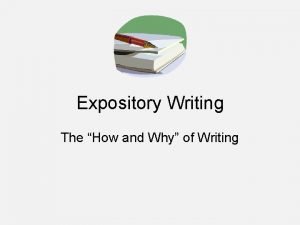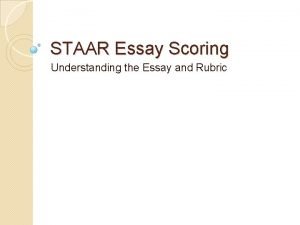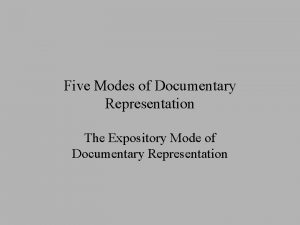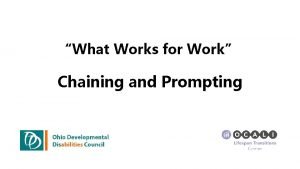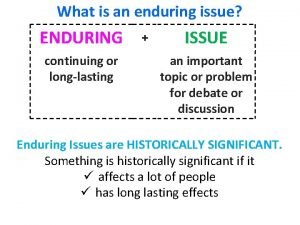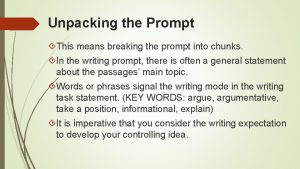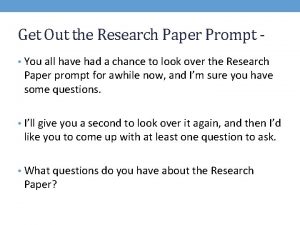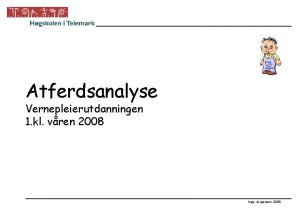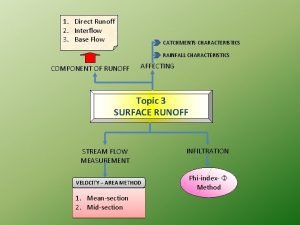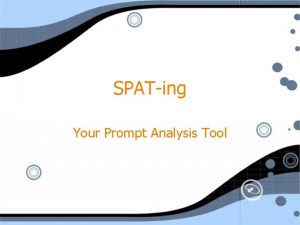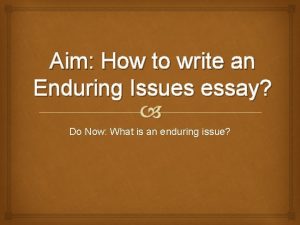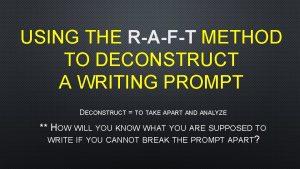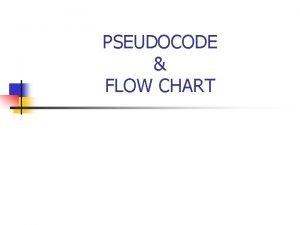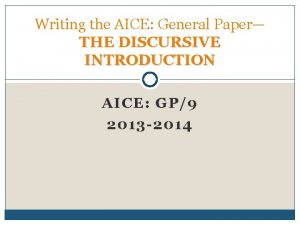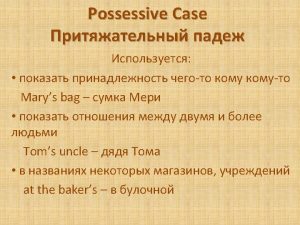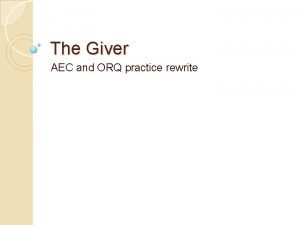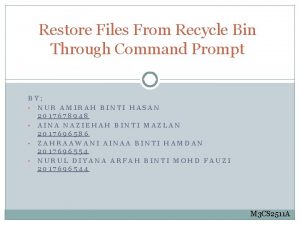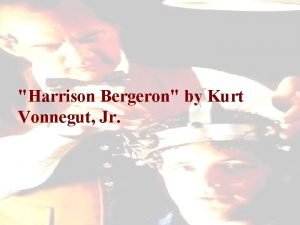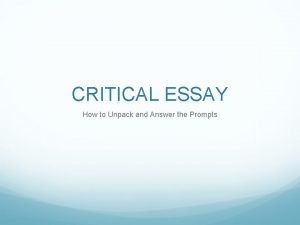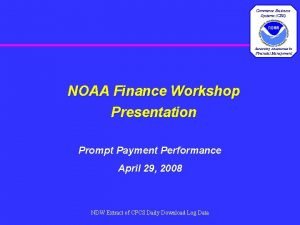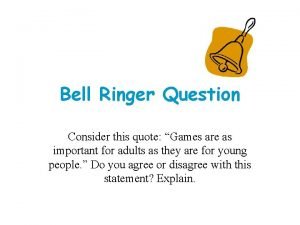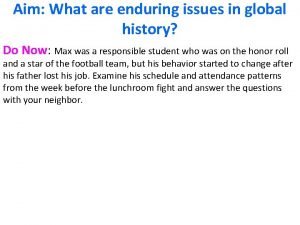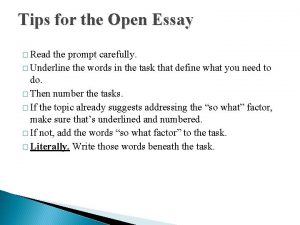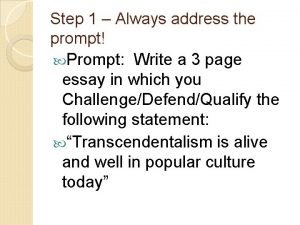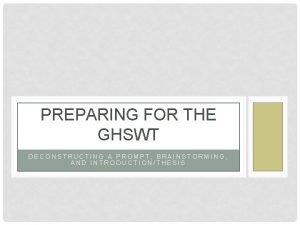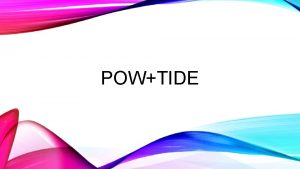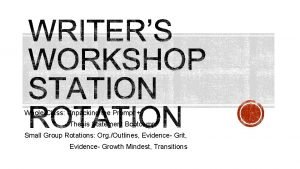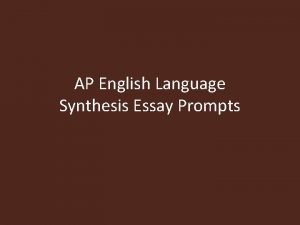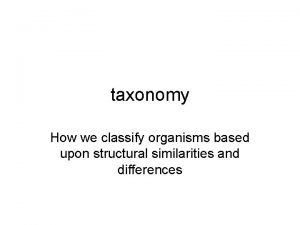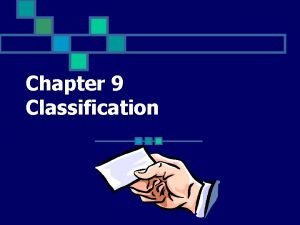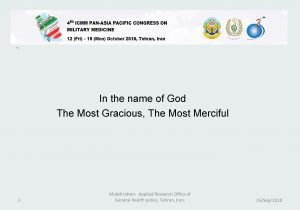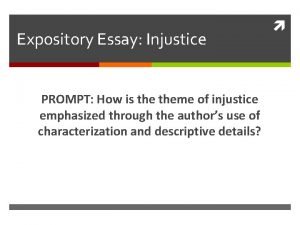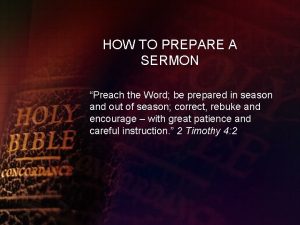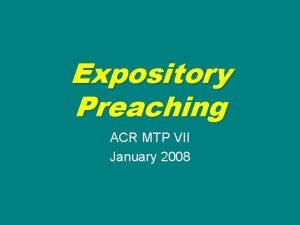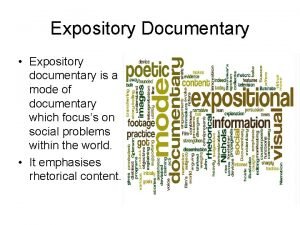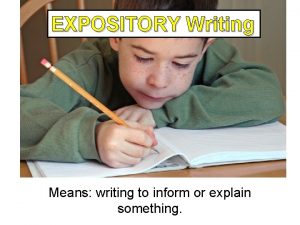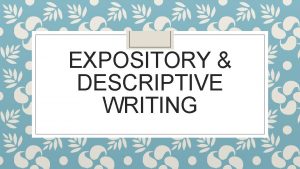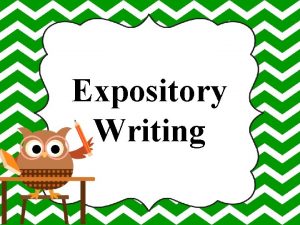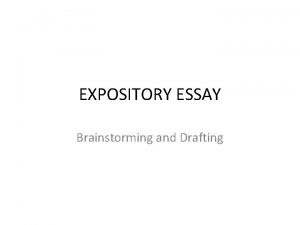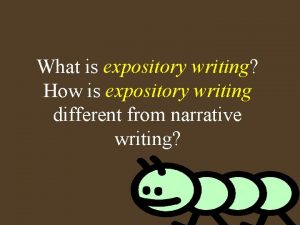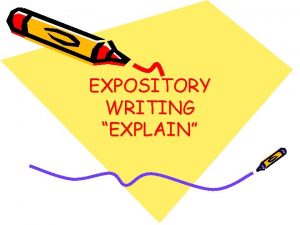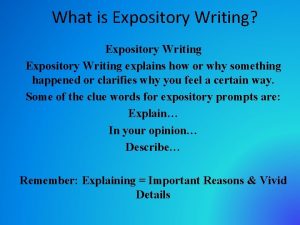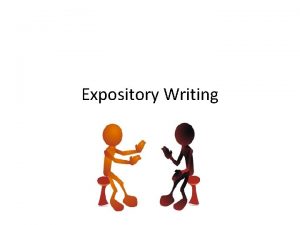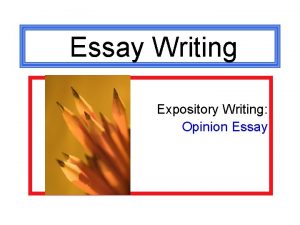FCAT Writing Example of an Expository Prompt Most




















































































































- Slides: 116

FCAT Writing

Example of an Expository Prompt Most students have favorite forms of transportation. Think about your favorite form of transportation. Now write to explain about your favorite form of transportation and why you like it.

Expository Writing l The purpose of expository writing is to: ¡ explain ¡ define ¡ tell how to do something by giving information l Good expository writing: ¡ Has a clear focus that is developed with details and facts to help the reader understand the writing.

Example of a Persuasive Prompt A local newspaper editor has published an article about how students should spend more time reading at home. Decide how you feel about spending more time reading at home. Now write to convince the local newspaper editor to support your point of view about whether students should spend more time

Persuasive Writing l The purpose of persuasive writing is to: ¡ persuade or convince l Good persuasive writing: ¡ Has a clear argument that is developed with details and facts to help the reader understand the writing.

The Parts of an FCAT Prompt 1. INTRODUCTION=TOPIC/WRITING INTRODUCTION SITUATION Most students have favorite forms of transportation. 2. Brainstorming for PREWRITING Think about your favorite form of Think transportation. 3. ACTION=Directions for WRITING ACTION Now write to explain about your Now write

What does the prompt want you to do? l Find the key words (EXPLAIN & CONVINCE) in the ACTION that tell you the type of prompt it is l Look in the third part of the prompt l It will say: Now write to… ¡ explain (expository) ¡ convince (persuasive)

How Is Your Response Scored? l With a RUBRIC ¡ Rubric: A scoring tool that lists the criteria for a piece of work or 'what counts‘ ¡ Criteria: 4 elements of writing

4 Writing Elements to the Score l 1. Focus=Main Idea, Theme or Unifying point ¡ l Presented & maintained throughout the whole response 2. Organization=Structure or Plan ¡ Transitions help you to do this. l l l 3. Support=Quality Details explain, clarify, or define ¡ ¡ l First of all, Secondly, Third, and most importantly. For instance, For example In addition, Furthermore. Overall, In short, In summary QUALITY=writer’s choice of words and how specific they are Complete, important and exact 4. Conventions=punctuation, capitalization, spelling, usage, and sentence structure.

FCAT Student Writing Rubric l l l 1 - Does not really address the topic, few if any details 2 - Writes about the topic a little bit, not organized clearly, a few supporting details, errors in writing 3 - Addresses the topic, organization can be seen, uses supporting details, uses correct capitalization and punctuation 4 - Focused on the topic, has organization, uses supporting details and explains some of them, commonly used words are spelled correctly 5 - Focused on topic, good organization and use of supporting details, a few errors in grammar

Write your own prompt! SAMPLE PROMPT Look at the sample prompt. Most students have favorite forms of l On your index card, transportation. you will write your own prompt. l Use your notes from Think about your yesterday. Be sure to favorite form of include the 3 parts: transportation. l ¡ ¡ ¡ Introduction: topic/writing situation Directions for prewriting Action: directions for writing Now write to explain about your favorite form of transportation

Grading Student Responses l You will work in groups of 3 or 4 l Your group will receive three different responses l You will read aloud the three responses l You will discuss each of the three responses. l You will then assign a number grade based on the rubric for each of the three responses (1 -6) and explain why in three sentences.

FCAT Student Writing Rubric l l l 1 - Does not really address the topic, few if any details 2 - Writes about the topic a little bit, not organized clearly, a few supporting details, errors in writing 3 - Addresses the topic, organization can be seen, uses supporting details, uses correct capitalization and punctuation 4 - Focused on the topic, has organization, uses supporting details and explains some of them, commonly used words are spelled correctly 5 - Focused on topic, good organization and use of supporting details, a few errors in grammar

Now that you know what is expected, follow the steps for your response from the prompt: l Figure out the topic from the introduction/ writing situation l whether it is expository or persuasive by looking at the signal word in the action l Prewrite using the brainstorming for prewriting Use a graphic organizer or outline l Begin to write the response using the directions for writing

Responding to a Prompt l When responding to a prompt, include 5 paragraphs ¡ Paragraph 1: Introduction ¡ Paragraph 2: Reason #1 Body Paragraph 1 ¡ Paragraph 3: Reason #2 Body Paragraph 2 ¡ Paragraph 4: Reason #3 Body Paragraph 3 ¡ Paragraph 5: Conclusion

TS Top of the Bun: Introduction Paragraph C S Topic Sentence (TS): the first sentence of the paragraph that tells what the paragraph will be about, include an attention getter. Supporting Detail Sentence (SD 1): Reason #1 to support topic Supporting Detail Sentence (SD 2): Reason #2 to support topic Supporting Detail Sentence (SD 3): Reason #3 to support topic Concluding Sentence (CS): the last sentence that summarizes the paragraph.

Lettuce: Body Paragraph/Reason #1 T S C S Topic Sentence: the first sentence of the paragraph that tells what the paragraph will be about. Reason #1: Supporting sentence with a detail Reason #2: Supporting sentence with a detail Reason #3: Supporting sentence with a detail Concluding Sentence: the last sentence that summarizes the paragraph.

Tomato: Body Paragraph/Reason #2 TS C S Topic Sentence: the first sentence of the paragraph that tells what the paragraph will be about, include an attention getter. Reason #1: Supporting sentence with a detail Reason #2: Supporting sentence with a detail Reason #3: Supporting sentence with a detail Concluding Sentence: the last sentence that summarizes the paragraph.

Burger: Body Paragraph/Reason #3 TS C Topic Sentence: the first sentence of the paragraph that tells what the S paragraph will be about. Reason #1: Supporting sentence with a detail Reason #2: Supporting sentence with a detail Reason #3: Supporting sentence with a detail

Bottom of the Bun: Conclusion Paragraph TS C S CONCLUSION PARAGRAPH: Summarizes the entire essay. Topic Sentence: the first sentence of the paragraph that tells what the paragraph will be about. Supporting Sentence: Restate three reasons in a new way. Concluding Sentence: the last sentence that summarizes the paragraph.

Do you know the parts of a response? l You will work in the same group as before l You will receive all of the parts of the response in an envelope l Your job as a group is to put it in the correct order as quick as possible and label each part. l The first group done will receive a prize!

Can I Get FRIES with that? l. Facts l. Reasons l. Incidents l. Examples l. Statistics

Facts=true statements that can be proven

Reasons=explain why

Incidents=based on your own experiences(Once, I…)

Examples=sample of the detail (For example, …. )

Statistics=numbers

FCAT Writing ORGANIZATION

Introduction Activity to Organization l Your friend is trying to explain to you how to make a peanut butter and jelly sandwich. He says, “Spread enough peanut butter on one piece of bread to cover it. ” l Visualize making a peanut butter and jelly sandwich. What are the next steps he would tell you? l Quickly jot them down.

What does ORGANIZATION mean? l Organization is the ability to tell things in an order that makes sense and makes it easy to follow.

Organization Activity You will work in small groups l It is your job to determine the introduction, body, and conclusion paragraphs. l You are going to put the essay back into its correct order and explain why you think it goes that way. l Remember: In a persuasive essay, the strongest argument should be presented LAST! l

An Organized Essay will have: l clear beginning, middle and end l transition words that are used to show connection and movement throughout the piece l events or supporting details that are organized in a logical sequence l a sense of completeness which ends with a conclusion

Beginning l GOOD The sand is hot under our feet. My mother and I run down to the beach. l BETTER My mother and I run down the winding path and onto the beach with our hair blowing in the cool, breezy wind. We walk quickly down on the hot grainy sand. The sand is so hot my toes curl up.

Middle l GOOD We sit down together and make a city of sand by piling the sand in pails and turning the pails upside down. l BETTER We find a smooth sandy spot and fill a big orange pail with the wet sand. Finally when the pail is full, we pat down the sand as flat as we can and gently turn the bucket over. Carefully we lift up the pail and the sand now becomes a building. Then we fill the pail again and again until we have a city of sand buildings appear.

Ending l GOOD l BETTER I feel good that I got to As we make our way back up the path, leaving our sand city spend this day at the behind, I peek over my beach with my mom. We shoulder and see a little boy start to head home at wandering toward our structures. Suddenly he squeals the end of the day. in delight, signaling to his mother to come see what he found. Eventually I turn back to the path, feeling relaxed and content after a wonderful day at the beach with my mom.

Why are transitions so important? l They make your writing clearer and flow smoothly l Create logical connections between sentences, paragraphs and sections of your paper l Also they can signal relationships l Look at your list of transitions, there are many of them to choose from!

What’s Missing #1? The painting on the library wall presents a lovely, lively seascape. In the foreground stretches a sandy beach littered with children. The center of the scene features a calm, crawling set of waves that seems to move gently toward the busy youngsters. Above, a cloudless sky sheds rays of sunshine on the beachgoers.

What’s Missing #2? Bill was asked to select and pack his favorite games for the long car trip. One choice included small board and pegs, a brain teaser. A Gameboy provided another challenge for his journey. The best game .

What’s Missing #3? As Billy looked at the yard, he mentally listed all of the work he would complete; then he started.

Tips for writing a well organized piece. . . l Open and close your essay. l Reread for transitional words and add them when needed. l Reread what you wrote and make sure you wrapped up your ideas

FCAT Writing Persuasive Writing

What is persuasive writing? l The purpose of persuasive writing is to convince the reader to accept a particular point of view (to believe in something) or to take a specific action (to do something).

Example of a Persuasive Prompt A local newspaper editor has published an article about how students should spend more time reading at home. Decide how you feel about spending more time reading at home. Now write to convince the local newspaper editor to support your point of view about whether students should spend more time

Writing Persuasive Response: Follow the same 5 paragraph format from last week l Paragraph 1: Introduction ¡ Begin with an attention grabbing beginning (statistic, quote, etc. ) ¡ Describe the issue (from the writing situation) ¡ State your stand/opinion on the issue (State whether you are FOR it or AGAINST it) l Paragraph 2: Reason #1 ¡ Evidence to support (FRIES) l Details l Paragraph 3: Reason #2 ¡ Evidence to support (FRIES) l l l Paragraph 4: Reasons #3 (Save your strongest reason for this paragraph) ¡ Evidence to support (FRIES) l l Details Paragraph 5: Conclusion ¡ Restate opinion

On the next slides we will look an example of a six point persuasive response. l Students were asked to persuade a newspaper editor whether students should spend more time reading at home (the sample persuasive prompt we looked at). l What is the writer trying to convince you to do or believe? l How do they support this? l How do they conclude their response?



You are now going to write your own persuasive response. l Remember: You only have 45 minutes. ¡ Prewriting: 5 -10 minutes ¡ Writing: 30 -35 minutes ¡ Editing (Reading your paper & correcting mistakes): 5 minutes

Your Prompt The school board is considering a rule that would prevent students who have failing grades from participating in school activities, clubs or sports. Think about whether students who have failing grades should or should not be allowed to participate in school activities, clubs or sports. Now write to convince the school board that students who have failing grades either should or should not be allowed to participate in school activities, clubs or sports.

After you finish writing, use the last 5 minutes to edit. l You should be able to say yes to the following: ¡ The way I’ve started my paper is effective; it would make the reader want to keep reading. ¡ I’ve told things in an order that makes sense and makes it easy to understand what I’m saying. ¡ The details in my paper go together or lead up to some bigger ideas, main point, or conclusion. ¡ My paper ends well; it doesn’t just stop suddenly, nor does it drag on too long.

FCAT Writing SUPPORT

What is Support? l Writing can be supported with: ¡ Facts: Smoking causes health risks. ¡ Incidents: I remember going to Disney World to celebrate my birthday. ¡ Reasons: My favorite time of year is winter because we have a two-week vacation. ¡ Examples: For example, March, May, and July each have thirty-one days. ¡ Statistics: One out of five middle school students have to walk to school. Direct quotations, dialogue, and sensory details that create images in the mind of the reader help support

Facts=statements that can be proven

Reasons=explain why

Incidents=based on your own experiences(Once, I…)

Examples=sample of the detail (For example, …. )

Statistics=numbers

Varied Support l Proficient papers contain different forms of support such as facts, incidents, reasons, examples and statistics, as well as rhetorical questions used for a specific purpose. l A strong writer will use three to four different types of support along with a reason.

To have proper support, your response must include the following: l Each body paragraph contains a reason, followed by a complete explanation with the use of additional, specific details using anecdotes, facts, or examples that further explain meaning.

Example of Varied Support Rhetoric al Question Incident Reas on Driving a Mazarati, Corvette, or Porsche at 90 miles per hour can be life-threatening because you won’t be able to stop the car to avoid an accident. Remember the movie, Fast and Furious? Everyone flooded theatre to see “tricked out” cars going faster than a speeding bullet. Everyone sped around town without accident. As a result of this Hollywood movie, sales for nitrogen skyrocketed because of the thrill of Fact driving at high speeds. What teenagers failed to realize is that not one vehicle had to stop suddenly in the movie. They didn't think re-enacting a scene or two was dangerous that it was just a movie. Who would have thought that the top consumers for Thompson and Hall Funeral Services would be those very teenagers attempting high speeds on busy streets filled with people.

When writing supporting paragraphs, be sure to answer all possible questions: l WHAT is your answer to the prompt? l WHY do you feel that way? l WHO do you have to back up your statement? l WHAT proof do you have to back up your statement? l WHEN have you seen your idea being used? l Explain HOW your idea makes sense.

Making the Connection l Proficient papers wrap up ideas by explaining HOW or WHY your support proves your reason.

Good Example of Making the Connection If paying high school athletes to play sports becomes reality, then schools will face the problem of being unfair to all. Many students participate in other activities besides the top sports. Think about the band; they are at every football game cheering on the future NFL stars, but because band is not considered a “sport, ” they will miss out on a little extra cash. Now that the subject of money has come up, the problem of which sports will have paid athletes will create tension between high school soccer players and football players, or volleyball players and track and field participants. Everyone would feel that their sport deserves more money than the other. If that doesn’t satisfy the greedy student, then schools may face a gender issue when high school male athletes feel

Better Example of Making the Connection If paying high school athletes to play sports becomes reality, then schools will face the problem of being unfair to all. Many students participate in other activities besides the top sports. Think about the band; they are at every football game cheering on the future NFL stars, but because band is not considered a “sport, ” they will miss out on a little extra cash. Now that the subject of money has come up, the problem of which sports will have paid athletes will create tension between high school soccer players and football players, or volleyball players and track and field participants. Everyone would feel that their sport deserves more money than the other. If that doesn’t satisfy the greedy student, then schools may face a gender issue when high school male athletes feel that more than half of the money should go to male dominated sports because “Male sports have more spectators. ” The arguments that may arise are like wheels on a car; they will just go

You have to SHOW, don’t just tell. You must SHOW not tell! The reader should be able to create an image in their mind while reading your writing. l Use words that appeal to all five of the senses: l ¡ smell ¡ touch ¡ taste ¡ sight ¡ sound Watch the film, "Show, Don't Tell. "

Look at these examples of SHOWING. l GOOD ¡ ¡ Reading classic books will help students understand the past. Everyone cannot be a professional. Driving a car can be very dangerous if you going very fast. Community service builds character. More Examples of Show, Don't Tell. l BETTER ¡ ¡ Reading To Kill a Mockingbird or Of Mice and Men will help take us back to what our parents call the “Good Old Days, ” and we call the 1930’s. Not everyone can be a doctor, lawyer, or CEO of a major company. Driving a Porsche, Mazarati, or Corvette can be deadly when you are driving 90 miles per hour. Cleaning up the neighborhood, being a big brother and sister, or feeding the homeless creates partnerships for life.

FIGURATIVE LANGUAGE l Figurative language is the ability to describe something by comparing it to something else. Some examples of figurative language are simile, metaphor, and personification. l The use of figurative language helps to paint a picture for the reader and should be used to help with creating “showing sentences” versus “telling sentences. ”

SIMILE: A comparison of two unlike things using the words like or as l With Out FIGURATIVE LANGUAGE ¡ Driving a car is dangerous. l With FIGURATIVE LANGUAGE ¡ Stepping on the gas to exceed 90 mph is like digging your own grave.

METAPHOR: A comparison of two unlike objects without using the words like or as l With Out FIGURATIVE LANGUAGE ¡ Community service in a senior citizen’s home can be rewarding. l With FIGURATIVE LANGUAGE ¡ Listening to Junior’s grandma talk about relationships is a medal in itself.

PERSONIFICATION: Giving human characteristics to non-living things l With Out FIGURATIVE LANGUAGE ¡ Being the head of a major company is hard. l With FIGURATIVE LANGUAGE ¡ As the CEO of Green Industries, I must say that being slapped in the face by a failed product does not send me to the bank smiling.

Group Activity: Practice with Show, don’t Tell. ¡ ¡ ¡ ¡ ¡ It was a dark and stormy night. The trash dumpster smelled terrible. She was my best friend. I hate asparagus. Billy was having a bad day. My teacher is really mean. The pizza tasted delicious. My grandmother’s kitchen smelled wonderful. She looked like she was in rough shape.

Sentence Variety l Adding sentence variety to prose can give it life and rhythm. l Too many sentences with the same structure and length can grow monotonous for readers. l Varying sentence style and structure can also reduce repetition and add emphasis. l Long sentences work well for incorporating a lot of information, and short sentences can often maximize crucial points.

1. Vary the rhythm by alternating short and long sentences. Example: The Winslow family visited Canada and Alaska last summer to find some native American art. In Anchorage stores they found some excellent examples of soapstone carvings. But they couldn't find a dealer selling any of the woven wall hangings they wanted. They were very disappointed when they left Anchorage empty-handed. l Revised: The Winslow family visited Canada and Alaska last summer to find some native American art, such as soapstone carvings and wall hangings. Anchorage stores had many soapstone items available. Still, they were disappointed to learn that wall hangings, which they had especially wanted, l

2. Vary sentence openings. l If too many sentences start with the same word, especially "The, " "It, " "This, " or "I”, it will get super boring! l For this reason, you need to use different ways to start sentences.

Example of varied sentence openings-Look at how many there are! Original: The biggest coincidence that day happened when David and I ended up sitting next to each other at the Super Bowl. l l l l Coincidentally, David and I ended up sitting right next to each other at the Super Bowl. In an amazing coincidence, David and I ended up sitting next to each other at the Super Bowl. Sitting next to David at the Super Bowl was a tremendous coincidence. But the biggest coincidence that day happened when David and I ended up sitting next to each other at the Super Bowl. When I sat down at the Super Bowl, I realized that, by sheer coincidence, I was directly next to David. By sheer coincidence, I ended up sitting directly next to David at the Super Bowl. With over 50, 000 fans at the Super l l l David and I, without any prior planning, ended up sitting right next to each other at the Super Bowl. Without any prior planning, David and I ended up sitting right next to each other at the Super Bowl. At the crowded Super Bowl, packed with 50, 000 screaming fans, David and I ended up sitting right next to each other by sheer coincidence. Though I hadn't made any advance arrangements with David, we ended up sitting right next to each other at the Super Bowl. Many amazing coincidences occurred that day, but nothing topped sitting right next to David at the Super Bowl. Unbelievable, I know, but David and I ended up sitting right next to each other

Strengthening Sentences l Brainpop on Strengthening Sentences

You are now going to write your own expository response. l Stay FOCUSED, ORGAIZINED & SHOW SUPPORT! l Remember: You only have 45 minutes. ¡ Prewriting: 5 -10 minutes ¡ Writing: 30 -35 minutes ¡ Editing (Reading your paper & correcting mistakes): 5 minutes

Your Prompt Most students have a school year that was especially memorable to them. Think about the year in school that stands out as most special in your mind. Now, write to explain to your reader why this was the best year you had in school.

FCAT Writing CONVENTIONS

Getting Started Translate the following into standard English: ¡ ¡ ¡ c u l 8 r. . . . ill be there b 4 8. . . . . you 4 got ur coat. . . . . were r u? . . . im w 8 ing for u outside. . . . going to meet dave at 10. c u there…. . . can u pick me up? 8 ok? . . . dont 4 get to call me. . . . call me ASAP. . . . . LOL!. . . . Kthxbye!. . . .

Conventions: The elements of language that help deliver the message. l Conventions refer to ¡ spelling ¡ grammar ¡ punctuation ¡ sentence variety l Errors in conventions are allowable as long as they do not keep the reader from understanding what you are trying to say.

A proficient paper includes: l Accurate spelling l Correct punctuation l Proper use of capitalization l Sound paragraphs l Grammar and usage are handled well

Peer Editing: Write the score you think your partner would receive. Write 2 things your partner DID & 2 things your partner DIDN’T do from the checklist below. l FOCUS: l SUPPORT: ____ I have a clear well-defined thesis or position. I have ____ I have clear knowledge of the topic. ____ included details to create ____ I have interesting valuable information that provides strong support. images in the reader’s mind or ____ My paper holds the reader’s attention by clearly defined the writer’s position. thoroughly answering the reader’s questions or ____ included facts, incidents, anticipates readers’ objections and questions. l ORGANIZATION: My paper has reasons, examples, statistics, ____ Clear, catchy beginning (lead) that makes my specific vocabulary, comparisons, audience want to read the rest of my paper. magnified moments, actions, ____ A lead that sets the topic or clarifies the main senses, reactions, and/or dialogue. issue. ____ Order that makes sense and guides my l CONVENTIONS: reader through the discussion. ____ I have some long and some ____ A middle that expands the topic introduced in short sentences for variety in my my lead or that presents and weighs evidence. writing. ____ Transitions that help connect the ideas in my paper. ____ I have reread my paper carefully ____ A concluding sentence or paragraph that and have corrected it for mistakes leaves my reader something to think about or pushes the reader toward a final decision. in spelling, punctuation, subject/verb agreement, capitals,

Looking at Complete Sentences l Sentence Fragments on Brain. Pop l Run-on Sentences on Brain. Pop

Complete Sentence l A complete sentence must have a subject and a verb. l What is a subject? The subject is the person or object the sentence is about. It always contains a noun (person, place, or thing) or a pronoun. In many cases, the subject should come first. l What is a verb? A verb usually tells the action of the subject or in some cases the state of being (feels, seems, looks). The

The subject is underlined once, and the verb is bolded. l 1. Amia and Skyler enjoy playing together after school. l 2. Ann loves to buy cookbooks that have French recipes. l 3. Sue is a wizard on computers. l 4. Science used to be boring, until I had a lab with Mrs. Phillips. l 5. Marcie, Angie, and Max appear to be best friends.

Complete Sentence Practice Find the subject & the verb in each sentence. 1. Stress appears to inhibit the ability of blood vessels to expand. 2. Friction over water resources constantly threatens conflict in the Middle East. 3. She has refused to negotiate with the guerrillas, calling them a gang of bandits. 4. Security was tight but fairly discreet at the event. 5. His attitude about taxes was openly hostile.

Singular Subject Verb Agreement l In every complete sentence, the subject and verb must agree. Singular subjects need a singular verb. l Singular subjects refer to only one individual or object that the sentence is about. l Singular verbs are actions or a state of being that usually end in the letter “s. ”

Plural Subject Verb Agreement l In every complete sentence, the subject and verb must agree. Plural subjects need a plural verb. l Plural subjects refer to more than one individual or object that the sentence is about. l Plural verbs are actions or a state of being that usually DO NOT end in the letter “s. ” l Example: Marcie, Angie, and Max appear to be best friends.

Sentence Variety: Simple Sentences l Mix up the type of sentences you use in writing. l Simple sentences are excellent to use to get short messages to the reader. l Example: I love reading books. ¡ Write two of your own simple sentences.

Sentence Variety: Compound Sentences l A compound sentence eliminates the use of too many simple sentences. l Example: Jane loves reading books. + I like going to the movies. =Jane loves reading books, and I like going to the movies. Write your own compound sentence combining the two simple sentences you just wrote.

Sentence Variety l A complex sentence specifically tells the reader what you want them to know. l Example: Although I enjoy watching movies, reading books is my first love. ¡ Write your own complex sentence.

Words Used Incorrectly: "It's" versus "Its" - (consistently the #1 problem in student papers) 1) It's: A contraction, meaning "it is" (as in "It's time for dinner. ") 2) Its: A possessive (as in "The dog was wagging its tail") Practice: 1. _____ up to you. 2. I knew what model car it was, but I wasn't sure about ____ color. 3. I'm afraid ____ going to be a very long season for the Mighty Ducks. 4. His pet duck reared ______ angry head when it

Words Use Incorrectly: "To, " versus "Too" (usually a close second behind it's-its) 1) To: Basic multi-purpose function word (as in "My goal is to die a millionaire. ") 2) Too: Adverb, meaning "very" or "excessively" (as in "The Tigers were too inexperienced to challenge the Yankees for the banner or flag. ") 3. Two: the number (two pencils, two dollars) Practice: 1. A person with a broken hip finds it usually hurts ______ much ____ stand. 2. More than ____-thousand-four-hundred years ago, Hippocrates told his patients ____ ease pain by chewing the outer covering of the willow tree. 3. They said the cost _____ keep it in space was _____ high. 4. It is not possible ____ see planets in the far universe because the stars the planets orbit are ______ bright. 5. Later ____ more groups crossed ____ Britain.

Words Used Incorrectly: There, Their, They’re 1) There: Refers to location (as in "that dog over there") 2) Their: A possessive (as in "They're going to bring their new car. ") 3) They're: A contraction, meaning "they are" (as in "They're on their way. ") Practice: 1. ______ are no excuses this time. 2. It's ____ car, so let them decide where we're going. 3. Wherever ____ are two or more firefighters in the same room, you know what they'll be talking about. 4. Whatever ____ doing to this highway, it seems to be taking forever to finish.

Words Used Incorrectly: "Have" versus "Of” The correct phrases are "could have, " "should have, " and "would have" -- not "could of, “ "should of, " or "would of. “

Words Used Incorrectly: Weather & Whether 1) Weather: Usually a noun (as in “How's the weather? ”) 2) Whether: conjunction that introduces possibilities or other options (as in “Do you know whether he is coming? ”) Practice: 1. I am going to get married ______ you like it or not. 2. We had some beautiful ______ for our holiday. 3. I’m not sure _____ I like the red one.

Periods Rule 1: Use a period at the end of a complete sentence that is a statement. l Example: I know that you would never break my trust intentionally. l ¡ Write your own sentence, using a period at the end of statement. Rule 2: If the last word in the sentence ends in a period, do not follow it with another period. l Examples I know that M. D. She is my sister-inlaw. Please shop, cook, etc. I will do the laundry. l Rule 3: Use the period after an indirect question. Example: He asked where his suitcase was. l ¡ Write your own sentence asking an indirect question,

Question Marks l Rule 1: Use a question mark only after a direct question. l Examples: Will you go with me? l Example of a non-direct question: I asked if he would go with me. l Write your own direct question, using a question mark.

Exclamation Points l Use exclamation points to show emphasis or surprise. Do not use the exclamation point in formal business letters. l Example: I'm truly shocked by your behavior! l Write your own sentence using a exclamation point to show emotion.

1. 2. 3. 4. 5. 6. 7. 8. 9. Capitalization and Punctuation Practice we toured an oil tanker in the harbor. this oil tanker is so big said little deer the tour guide that three football fields could fit on its deck harry asked how can I learn more about these ships One of the girls said That she had seen underwater oil pipelines. These salmon swim against the current of kenai river in alaska to return to the place they were born My cousin richard visited mammoth cave in kentucky during the summer Why did you send your cards to north pole, colorado, during december The tacoma narrows bridge collapse not long after it opened On Sunday I read a story called “all for one” by a young

Great Beginnings…. Great Endings l When you begin a paper, you want to make sure your reader wants to keep reading because it is that interesting ¡ include an attention getter ¡ clearly state your topic l When you end your paper, you want to make sure you finish strong ¡ restate your thesis sentence & 3 reasons in a new way ¡ do not include new information

Expository Examples The following are taken from eighth graders’ explanations of why they would like to trade places with someone for a day. If I could be one person for a day, I would like to be my great-grandpa Nathan Payne. he is a kind and loving man, my best friend in fact. As you can see, my great-grandpa was a “great” man. I would love to be him just for one day, or even for one hour, for that matter! But, if I were him for any amount of time, there is one question I would have to ask, Could I fill such a great man’s shoes?

Expository Examples The following are taken from eighth graders’ explanations of why they would like to trade places with someone for a day. “Eric! put your head in the window! What do you mean what did you do? ! Do it! Now!” This, and more, is what my bus driver, Mrs. _____, has to go through day after long day. That, and some more reasons, is why I would like to trade places with her. I want to know how she can do it. I’ll admit this is not the most glamorous person in the world to trade places with, but ti fascinates me. My first reason is…. These are just some reasons why I would like to be my bus driver for a day. A lot of people take bus drivers for granted. They think it is easy to drive a big bus on busy roads filled to the brim with kids. Well it is not. Bus

Expository Examples The following are taken from eighth graders’ explanations of why they would like to trade places with someone for a day. Melissa _____ is a person with lots of qualities I’d like to have. She is outgoing (a very strong extrovert), a talented dancer, and a total opposite of me. If I could change places for one day with somethone, she would be the one. Melissa has lots of qualities I wish I had, but she is a lot different than me. maybe it would be harder than I expect. But for one day, 24 hours, I think it would be fun to be a talented dancer, an extrovert, and the only child. But only for one day would I want to be her, because I would miss my life and my horses.

Persuasive Examples The following are taken from eighth graders’ persuasive papers written to convince the reader to accept their point of view on the elimination of certain classes. The clang of the school bell rings in your ears. The academic classes you were just in bored you and yawning seemed to be the only thing keeping you awake. There’s now a bounce in your step as you literally waltz to your next class. It’s your favorite class of the day, music. The rhythmic notes and chimes stimulate your senses. As you arrive to class, a notice on the door catches your eye—music class is cancelled. You feel angry and deprived. You no longer have the desire to come to school. Your grades lower as does your wish for learning. Because of the elimination of art, music, and physical education classes, school will have become duller, less motivational, and less stimulating for students. Because of the elimination of art, music, and physical education classes, school will have become duller, less motivational,

Persuasive Examples The following are taken from eighth graders’ persuasive papers written to convince the reader to accept their point of view on the elimination of certain classes. A seven hour day at school filled with seven classes. Of those seven classes, you rip your hair out by the roots over four of them. In history you have a ten-page report on the Civil War, and you wake up hearing the bullet of Booth’s gun whirling through the air toward President Lincoln. In science you must violently scribble down a paper on the importance of Archimedes's Principle. At night when you are just about to fall asleep you are hurled back in consciousness, and instead of seeing a time on the clock you see the all too familiar words, “If the buoyant force is greater than the gravitational forces…” The only classes you actually walk into with the slightest smile on your face art, music and physical education. If it weren’t for these classes, your body would never again be seen getting on the big yellow bus that takes you to hall of nightmares known as school. By keeping courses such as art, music, and physical education as

Persuasive Examples The following are taken from eighth graders’ persuasive papers written to convince the reader to accept their point of view on the elimination of certain classes. Art, music, and physical education classes should definitely not be eliminated from the school curriculum. These subjects, although non-academic, build social and artistic skills that are just as, or maybe more important than, academic subjects. All of these subjects help a child in building his/her character and personality. They let kids who aren’t academically inclined develop their own talents and showoff, and feel important. These subjects expose a student to new opportunities and help them develop a better understanding of people. The skills that can be

Great Beginnings…Great Endings Practice l Using the examples we just viewed as a model, create a great beginning and a great ending for these topics ¡ a description of the best meal you ate ¡ a letter to the school board about students’ rights

You should be able to say yes to these questions about conventions when you finish writing: l I have some long and some short sentences for variety in my writing l I have reread my paper carefully and corrected it for mistakes in ¡ spelling ¡ mechanics ¡ sentence structure ¡ punctuation

Writing Persuasive Response: Follow the same 5 paragraph format from last week l Paragraph 1: Introduction ¡ Begin with an attention grabbing beginning (statistic, quote, etc. ) ¡ Describe the issue (from the writing situation) ¡ State your stand/opinion on the issue (State whether you are FOR it or AGAINST it) l Paragraph 2: Reason #1 ¡ Evidence to support (FRIES) l Details l Paragraph 3: Reason #2 ¡ Evidence to support (FRIES) l l l Paragraph 4: Reasons #3 (Save your strongest reason for this paragraph) ¡ Evidence to support (FRIES) l l Details Paragraph 5: Conclusion ¡ Restate opinion

You are now going to write your own persuasive response. l Stay FOCUSED & ORGAIZINED, SHOW SUPPORT and USE PROPER CONVENTIONS! l Remember: You only have 45 minutes. ¡ Prewriting: 5 -10 minutes ¡ Writing: 30 -35 minutes ¡ Editing (Reading your paper & correcting mistakes): 5 minutes

Your Prompt The principal of your school does not think that having candy and soda machines in school is a good idea. Think about the reasons why having a candy and soda machine in school is a good idea. Now write to convince your principal whether having candy and soda machines in school is a good idea for the school.

Peer Editing: Write the score you think your partner would receive. Write 2 things your partner DID & 2 things your partner DIDN’T do from the checklist below. l FOCUS: l SUPPORT: ____ I have a clear well-defined thesis or position. I have ____ I have clear knowledge of the topic. ____ included details to create ____ I have interesting valuable information that provides strong support. images in the reader’s mind or ____ My paper holds the reader’s attention by clearly defined the writer’s position. thoroughly answering the reader’s questions or ____ included facts, incidents, anticipates readers’ objections and questions. l ORGANIZATION: My paper has reasons, examples, statistics, ____ Clear, catchy beginning (lead) that makes my specific vocabulary, comparisons, audience want to read the rest of my paper. magnified moments, actions, ____ A lead that sets the topic or clarifies the main senses, reactions, and/or dialogue. issue. ____ Order that makes sense and guides my l CONVENTIONS: reader through the discussion. ____ I have some long and some ____ A middle that expands the topic introduced in short sentences for variety in my my lead or that presents and weighs evidence. writing. ____ Transitions that help connect the ideas in my paper. ____ I have reread my paper carefully ____ A concluding sentence or paragraph that and have corrected it for mistakes leaves my reader something to think about or pushes the reader toward a final decision. in spelling, punctuation, subject/verb agreement, capitals,

Tips for Test Day l l l l Be sure to be present on test day. Students taking tests on make up days tend to score lower. Eat a good breakfast. Hunger can lead to poor performance. Relax! All of the hard work is done. Now is just the time to prove that you have been working hard and have learned what is expected of you. Get to school on time and be sure to talk with friends to break the tension. Avoid all strenuous activity before school such as running, football, and baseball. Listen carefully to all test-taking directions given by the teacher and ask questions about those directions that are not clear. Think positively; tell yourself that you can do this. To help calm down, breathe in and out slowly and deeply.

l l l Tips for FCAT Writes! Memorize the following FCAT writing rubric: Focus, organization, support, and conventions. Write just as you do for all of your teachers. Remember you are in school and you are in one of your teachers’ classrooms. Recall writing strategies from class and write down the main points that must appear in your writing. Write legible, complete sentences and paragraphs, and focus on your main idea. Read the prompt carefully. As a matter of fact, read it at least two times. Plan your writing by organizing your ideas. Support your ideas by telling more about each reason or argument. Use a variety of sentence structures. Choose words that help others understand what you mean. Use facts, incidents, reasons, examples, and statistics (FIRES) to support your topic sentence. Review and edit your writing. In your review, check spelling, punctuation, and capitalization. Be sure that the reader is able to TOUCH, TASTE, SEE, SMELL, AND
 Expository writing prompt
Expository writing prompt Stimulus control occurs when
Stimulus control occurs when Response prompt vs stimulus prompt
Response prompt vs stimulus prompt Students to wring more from
Students to wring more from Ways to start a sentence
Ways to start a sentence Fcatexplorer.com
Fcatexplorer.com Fcat star
Fcat star Fcat science 8th grade
Fcat science 8th grade Fcat vs fsa
Fcat vs fsa Fcat reference sheet
Fcat reference sheet Read and writing prompt carefully
Read and writing prompt carefully Read and writing prompt carefully
Read and writing prompt carefully Character trait essay
Character trait essay Character description writing prompt
Character description writing prompt Alternate ending writing prompt
Alternate ending writing prompt Read the writing prompt carefully
Read the writing prompt carefully The scarlet ibis essay
The scarlet ibis essay Breaking down a prompt
Breaking down a prompt Writing prompt
Writing prompt Intelligent machines act essay
Intelligent machines act essay Writing prompt and evidence chart
Writing prompt and evidence chart Enemy pie writing prompt
Enemy pie writing prompt Expository pillar
Expository pillar Define expository paragraph with example
Define expository paragraph with example Thesis statement prompts
Thesis statement prompts Example of speech essay conclusion
Example of speech essay conclusion Sequence of process writing
Sequence of process writing Expository text problem solution examples
Expository text problem solution examples Ayon kay hellen keller ang pagsulat ay
Ayon kay hellen keller ang pagsulat ay Informative essay definition
Informative essay definition Elaboration transition words
Elaboration transition words Staar released writing prompts
Staar released writing prompts Explain expository writing
Explain expository writing Tchart
Tchart Essay parts
Essay parts Expository essay argumentative
Expository essay argumentative Elements of expository writing
Elements of expository writing Narrative writing reveals something of importance.
Narrative writing reveals something of importance. Expository writing hooks
Expository writing hooks Nature of expository text vs narrative text
Nature of expository text vs narrative text Expository and persuasive
Expository and persuasive Staar test writing prompts
Staar test writing prompts What is expository text?
What is expository text? Hamburger style writing
Hamburger style writing Discusses advantages and disadvantages
Discusses advantages and disadvantages Advantages and disadvantages of writing essays
Advantages and disadvantages of writing essays Expository writing hooks
Expository writing hooks Writing that explains
Writing that explains Staar essay examples
Staar essay examples Expository writing
Expository writing Rules of expository writing
Rules of expository writing Staar writing prompts english 1
Staar writing prompts english 1 Staar essay
Staar essay Expository essay patterns
Expository essay patterns Expository documentaries
Expository documentaries Formal vs informal article
Formal vs informal article What is tap in writing
What is tap in writing Forward chaining
Forward chaining How to write an enduring issue essay
How to write an enduring issue essay Unpacking the prompt
Unpacking the prompt Research paper prompt
Research paper prompt Prompt atferdsanalyse
Prompt atferdsanalyse Prompt atferdsanalyse
Prompt atferdsanalyse Ap synthesis prompt
Ap synthesis prompt Prompt interflow
Prompt interflow Prompt analysis
Prompt analysis Olivier prompt
Olivier prompt Example of enduring issue essay
Example of enduring issue essay Aice general paper 1
Aice general paper 1 Raft writing prompts
Raft writing prompts Prompt topic
Prompt topic Shadow prompt aba
Shadow prompt aba Prompt pseudocode
Prompt pseudocode Most-to-least prompting example
Most-to-least prompting example What's your kink meme
What's your kink meme Aice general paper discursive essay
Aice general paper discursive essay Correctly , bold, carefully ,prompt
Correctly , bold, carefully ,prompt The giver essay prompts
The giver essay prompts Prompt book romeo and juliet
Prompt book romeo and juliet Being prompt
Being prompt Bootsect bak restore
Bootsect bak restore Harrison bergeron annotations
Harrison bergeron annotations How to unpack an essay question
How to unpack an essay question Prompt business systems
Prompt business systems Bell ringer questions
Bell ringer questions Enduring issues essay example global history
Enduring issues essay example global history Open prompt essay
Open prompt essay How to address a prompt
How to address a prompt Deconstructing a prompt
Deconstructing a prompt Tide prompt
Tide prompt Amt setup prompt
Amt setup prompt Unpacking the prompt
Unpacking the prompt Prompt ge
Prompt ge Proton vda
Proton vda Ap lang synthesis essay prompt 2007
Ap lang synthesis essay prompt 2007 Most general to most specific classification
Most general to most specific classification Most general to most specific classification
Most general to most specific classification Allah the most gracious
Allah the most gracious In the name of allah the most beneficent the most merciful
In the name of allah the most beneficent the most merciful Ponceau pronunciation
Ponceau pronunciation Guddi baji
Guddi baji This is the study of grouping and naming organisms
This is the study of grouping and naming organisms The arrangement chapter 9
The arrangement chapter 9 In the name of god most gracious prayer
In the name of god most gracious prayer In the name of allah the most gracious
In the name of allah the most gracious In the name of allah the beneficent the merciful in arabic
In the name of allah the beneficent the merciful in arabic In the name of god most gracious most merciful
In the name of god most gracious most merciful Aqeedah in islam
Aqeedah in islam In the name of god the most gracious the most merciful
In the name of god the most gracious the most merciful Allah the most beneficent
Allah the most beneficent Example of expository
Example of expository Injustice thesis statement
Injustice thesis statement Example of expository paragraph about family
Example of expository paragraph about family How to prepare to preach the word of god
How to prepare to preach the word of god Homiletics sermon examples
Homiletics sermon examples Expository mode definition
Expository mode definition Expository paragraph examples
Expository paragraph examples
